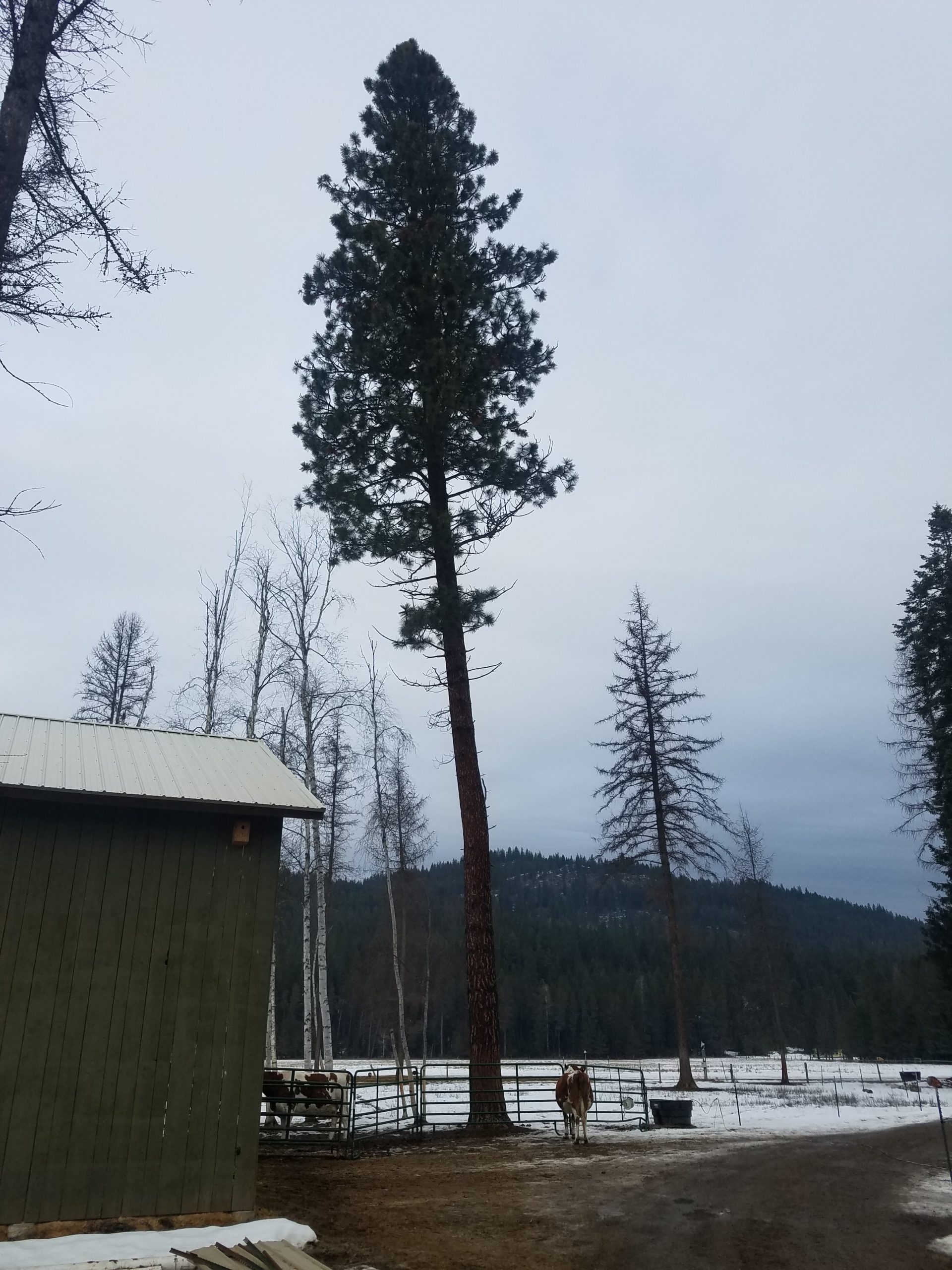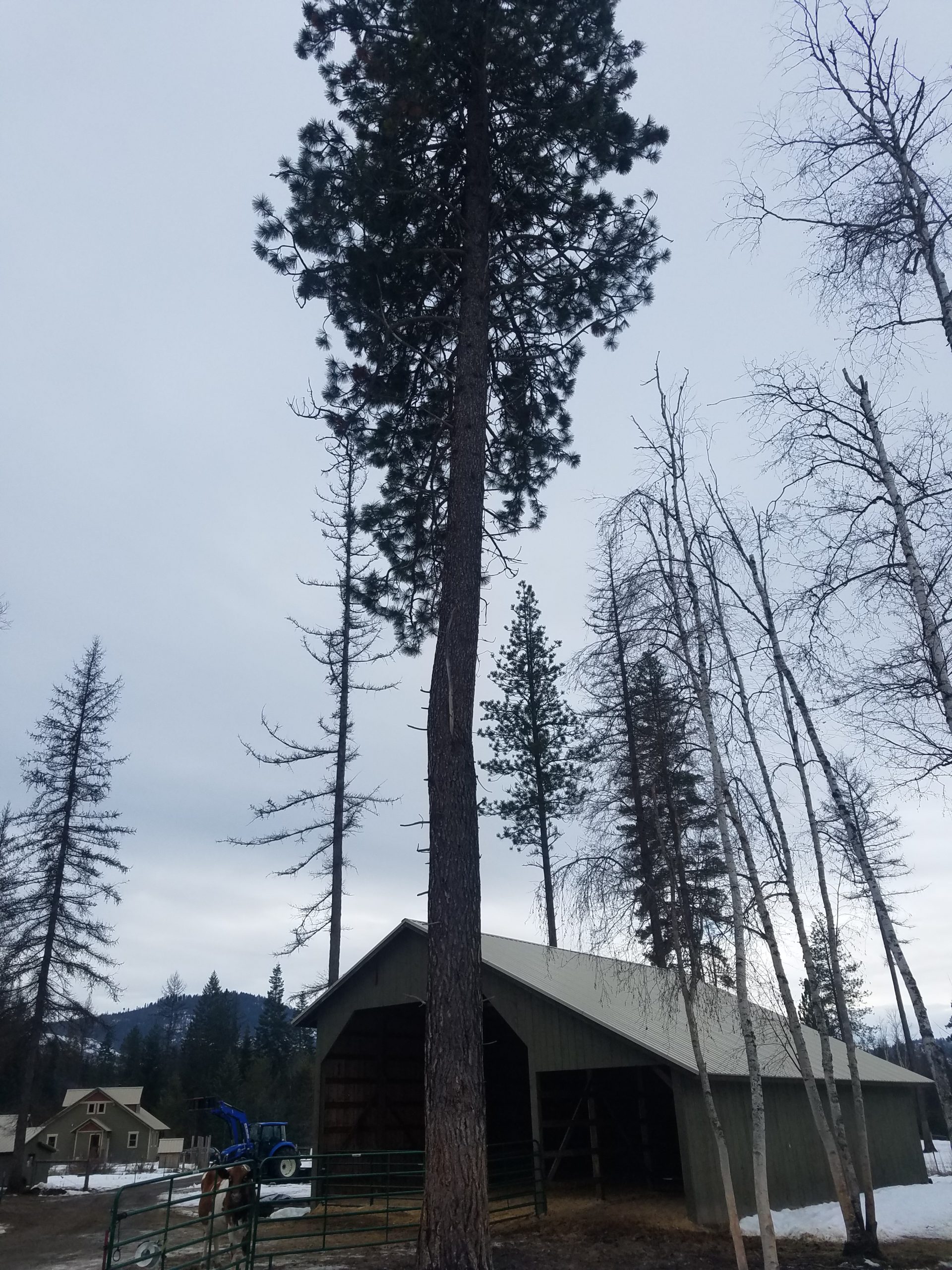Having a large ponderosa pine tree growing right next to the cow barn, on the north side in fact, and with north winds seemingly getting stronger in the last several years, it was time for a hazard tree removal.



Years ago, this property was entirely a dense forest with large trees. Within that forest was this large ponderosa pine tree. Its age is at least 100 years old, and it was healthy, but with an interesting looking “crook” or bend about 30 feet up that caused it to lean slightly south. Also, there was a larger branch load on the south, and further up the tree, the tree split into two different tops.
I liked the tree because it served as a great perching point for many birds, including herons occasionally landing there.
When I removed the forest, and in fact after I had built most of that cow barn, which at the time was intended to be hay storage, I left the ponderosa there. I reasoned that it was exceedingly well-rooted, and did not have any obvious defects.
Also, even using a 55,000 pound excavator to push it over requires digging a decent-sized hole on three sides of it, and still takes effort. Ponderosas can be just exactly that well-rooted, especially in a clay soil. Furthermore, at the time, I did not have a use for lumber from it. So, I left it there (this was in 2014).
Since that time, with still a few trees left here and there to provide shade for animals and perching spots for birds, we have been finding that north winds seem to be more fierce than they used to be, particularly after removing the surrounding forest. In the past several years, we have had numerous trees go down, mostly in the bull pen and in the forest line between our north field and the south 20.
Watching the wind blow and really tweak on this tree, I realized that this tree is quite hazardous, and based on watching old ponderosas topple in many locations, especially in the last two years, root balls and all, it became obvious this tree is a danger to the building. Particularly, this tree was dangerous because cows will likely be sheltering in the building when the tree goes down. No tree is important enough to risk building and especially cows. The potential loss is just too great.
So, it became my commitment as of early fall 2020 to remove the tree. Usually, I do these things myself, but with the branch load, the slight lean, and the proximity to the building and potential loss should things go wrong, I decided this was a job for a large machine or professional.
Since I have no plans to rent a large machine soon, I called an excavating company I have had do a couple of jobs for me. He told me he would drop by and give me an estimate at the end of October or early November. He never showed.
Then I forgot about it for a bit, but it was still in the back of my mind. I needed a hazard tree removal! As we headed toward the end of the year, I tried contacting a local tree service. He was very courteous to call me back on a Sunday and promised to drop by within a few days, but he never did. I called him again a week later, and he promised the same, and never came.
So, I contacted a second tree service. I got the same result.
This week, I took a look at that tree and thought – it has to be gone before the next arctic front comes. I texted one of my clients, who owns a logging company. She called her husband, and he came out yesterday afternoon within three hours of me contacting her.
He assessed the tree and said, yep it should be taken out. We decided on a falling direction and a strategy and I asked him when he wanted to do it. His reply, “I have my chainsaw right now!”
Okay. So, we had decided I would also push on the tree with my Gradall, just slightly, in order to act as our insurance policy in case anything went wrong.
While he got suited up in safety gear, I fired up the Gradall and quickly knocked over two birch trees that were dead and in the falling patch of the ponderosa. Then, I put a meal out for the heifer group so they wouldn’t approach the fall line while Alex (Barnhart) got to work.
He made his notch while I lined up the Gradall and then he made his back cut and put wedges in etc. I pushed slightly on the tree and he finished the backcut.
The tree came crashing down perfectly in the fall line. According to my daughters, who were in the house several feet away, it made enough of a thundering sound on impact with the ground that the cats laying around all started.
Alex, with some help from me, quickly delimbed it and cut it into 20 foot logs, and then I thanked him and he left. I finished the job by using the Gradall to push all the slash into a pile, and deck the logs for a future trip through my Woodmizer. Mostly likely, this hazardous tree removal will result in great green pine siding for my future commodity barn at the front of the farm.
All in all, the total job took from about 3 pm to 5:30 pm by the time the logs were decked and the slash piled. We made sure to pile high so the heifers and steers don’t stand around munching too many pine needles – since those aren’t generally good for them and can especially be abortifacent for cows in their third trimester of pregnancy, though there are none in that group currently.
Alex was an awesome guy to do that for me! It took a bit of stress off me. I told him I get very nervous falling tall trees like that around buildings, though generally I have been very accurate. He said he feels the same way, though generally (he did not say this but I know it to be true), he is exceedingly accurate.
Trees are great, just not when they could potentially destroy a building. Do you know exactly how dense and heavy a ponderosa pine tree is? Very. Had it ever fallen on the barn, it would have been very devastating in its effect. I am very pleased to see it no longer in the sky line.
Jean Azlein
So happy to hear the happy & safe ending! But the process (no shows) is not good to hear. We lived on Huntington Beach, CA for 20 years. I walked the dogs daily in the wetlands & loved to watch the herons & other birds. I’m thrilled to hear that I might see them here.
Have the calves been born yet?
Paul Herndon
There are lots of herons and other wonderful birds up here. We regularly see herons fly up our creek valley from the river. We had two calves born recently – both girls. They are very cute. Currently one is almost 8 weeks old, and the other almost 5 weeks. The 8 week old is the aunt to the 5 week old. Name of the aunt is Danica and the neice is Fiona.
Jean Azlein
I am smiling about the birds. We had 1 Gt Blue Heron (that’s all I ever saw at a time) where we lived in OR & I loved to see it. It reminded me of CA home.
I love the names of your babies. I hope they will grow up to be wonderful milk providers. And an aunt & niece. How fun!
Casey
I’m glad you don’t take falling a tree lightly, especially an old one. 🙂 Could you imagine the weight of that thing when filled with snow, or during a spring storm when it’s full of cones?? It did get to live its quirky life, now immortalized in your blog post. <3
Paul Herndon
Thanks for the comment! I have felled a lot of big trees, both with saw and large excavator and all of them deserve respect. These ponderosas weigh more than most. The logs are uncommonly heavy and I just know these things would seriously crush anything they came down on. Alex has his own experiences as a professional logger, and yes, they all deserve the utmost care and attention 🙂
Jamie
Paul, it is unprofessional for a business not to at least return a phone call, but thankful it was done after-all. Seems to be it was just meant to be for the logging fellow to do it with (for) you. Wonderful to hear it was a safe event and now the ponderosa pine tree will be reincarnated into siding for another building.
Good news, great outcome! *thumbs up*